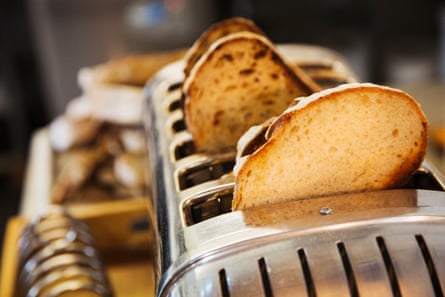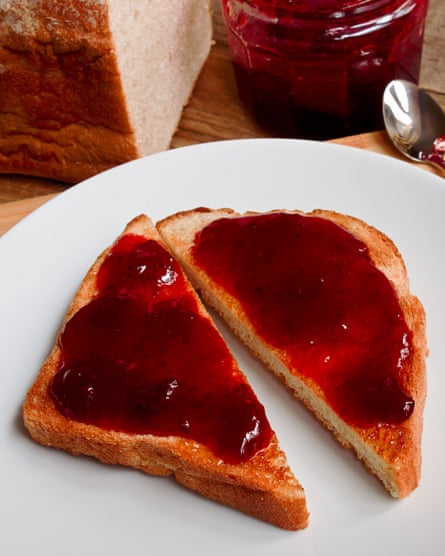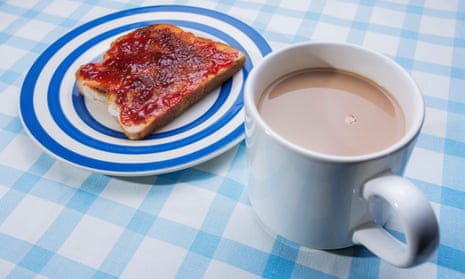Politically, it is said, Britain tolerates endless promises of jam tomorrow, never demanding jam today. But now the country has seized its own destiny – at least in the literal matter of jam.
Rewind to 2019 and jam was over. Dying. In terminal decline. Jam was as cool as a tweeting a laugh-cry emoji about the state of Kings of Leon’s skinny jeans. But, during the pandemic, jam has enjoyed a dramatic revival. “Breakfast has been reborn,” trilled the Grocer magazine as it reported jam sales had increased in value by almost 23% last year.
In many ways, this is no surprise. Porridge will have played its part; baking, too. But a lot of that growth will be down to the fact that toast and jam – the subject of this How to Eat (HTE) – is a remarkable antidote to the gloom and exhaustion of lockdown. On the overcast, rain-lashed winter-spring mornings and afternoons of our perpetual pandemic incarceration, toast and jam can do a lot of heavy lifting. For a moment, real life melts away.
But that is true only if that jam is tight and the toast is right. That is where HTE – the Guardian’s most power-mad, pernickety food guide – comes in. Put the kettle on, Britain: this one matters.
Apparatus maintenance
Ever wondered why Britain is not a socialist utopia? Look at how people treat one another through the prism of toast, butter and jam. In any communal dwelling, the experience is soured frequently by selfishness: crumbs left in butter; toaster settings tinkered with; more crumbs on worktops; a token, useless smear left in the butter dish; and, most heinous of all, butter knives scraped on to the lip of the jam jar until it looks like a hazardous laboratory sample. Is that butter or bacterial growth floating in there? Is that … mould?

Do not misunderstand HTE. It is not particularly fussy. It does not rule HTE Towers like an aged dowager aunt, forever banging its angry palm on a copy of Debrett’s. But the chaos that occurs on the toast-butter-jam axis is infuriating precisely because it is so avoidable. You need not run your domestic kitchen like a hotel (individual butters, jams in ramekins) to avoid it. People simply have to be better. Thinking of others, not just their own convenience.
First, crumbs in the butter. Why? The historical solution was using a dedicated butter knife to transfer butter to your plate. But that is unnecessary faff. By simply wiping your knife* on the crust-edge of your toast between approaches, you will minimise the transference of crumbs. If some debris does end up in the butter, then, using a clean section of the knife’s edge, tidy up the pat by lightly scraping off the crumbs (and use that crumby butter on your toast).
The same applies to butter mixed through jam or deposited on the jar’s lip. How is this preferable to spreading extra butter on your toast? Who has ever recoiled in horror, exclaiming: “Oh my God! I can’t eat this, it’s got way too much butter on it”? No one.
People who leave such mess in their wake are the same people who decorate trees with bags of dog poo, ride bikes on the pavement or leave half-eaten food on bus seats. They are self-absorbed individuals who, when questioned, are always ready with a spurious justification, oblivious to how their self-interest erodes our common enjoyment of the public realm.
*Rather than a dedicated butter knife (stubby, heavy, curved-tip, often overdesigned and clumsy), use a simple, smooth, nonserrated blade, similar to but smaller than a palette knife.
Toasting

In 2014, HTE had a funny turn. Maybe it just needed a better toaster. In retrospect, its insistence on using the grill to make toast was perverse. Grilling toast requires an untenable hawk-like attentiveness to catch it at its optimum doneness in that infinitesimal window between “still bread” and “carbonised Pompeii relic”. HTE is reconciled to the toaster as the realistic compromise: the Keir Starmer of kitchen appliances.
This is no small matter because, mavericks such as Jay Rayner aside, no one likes burnt toast, particularly with jam. In this supposed sweet, creamy mouthful, that blackened acrid bitterness is ruinous. Literally, ashes in the mouth.
Triangular or rectilinear?
Toast topped with a spread should always be cut diagonally, so you can eat in, from the sharp end, without smearing the spread all over your cheeks.
Bread options
There is no such thing as bad bread. Even woolly, airy factory loaves that toast into dry, friable slices of disappointment are better than, for instance, comparable quality porridge, a smoothie or that psychopathic start to the day, “black coffee at 6am while I check my emails”. It is carbs. They are life. Eat!
But not all toast is equal, in jam terms, for two reasons. HTE refuses to believe jam is enjoyable on darker, rye-to-wholemeal breads. In their earthy flavours, they are unsuited to this essentially sweet treat. With jam, stay in the 50:50-to-white spectrum. The other factor is that not all supermarket loaves are dense and robust enough to produce a truly satisfying slice of toast (tip: Jackson’s bloomers, Warburtons Toastie).
Were money no object, HTE would always opt for a good (off-)white sourdough. There is a lot of nonsense talked about sourdough on the toast and jam-front. It is too thick (er, cut thinner slices?), the crust is too chewy (sigh!), butter seeps through the holes (what of it?). Sourdough’s textural superiority and the lactic twang it delivers, a palate-cleansing flourish at the end of each mouthful, make it the pre-eminent choice.
The butter assumption
Other fats are available, but please do not use them.
Ratios

Think of jam not as a topping, but as a seasoning for bread and butter. Like a croupier shuffling cards, an elaborate mosaic or two lovers’ interlinked fingers, the aim is to weave elements together in a way that is elegant, balanced and mutually reinforcing. It is not a fruit-forward assault on the senses. If you like jam that much, eat it straight from the jar.
The toast needs to be spread liberally with butter, but the jam should be a 1-2mm screed across the top. No pools, no lumps, no hillocks. If you overdo it, the jam will create an overbearingly sweet mouthful. The flavour should be butter, underpinned by toast, the jam a restrained spritz of fruity sweetness up top.
You may argue that, rather than commercial jam, rocking a mandated minimum of 60% sugar, you could opt for reduced-sugar versions or less overtly sweet preserves or conserves, which you could then trowel on. Not only would that thicker layer be unpleasantly wet and sticky, but lower-sugar options often taste comparatively dull and lifeless – worthy, even. They lack the sugary sparkle, the zip and pizazz of industrially processed fruit spreads. Less of the most intensely sweet version is more in jam’s case.
Texture and flavour
On that basis, a smooth, seedless, firmly set jam is essential. No one wants rogue pieces of fruit disturbing the momentum of this snack, with their intrusive bursts of real flavour, pips, skin and fibres.
The rustic farmhouse aesthetics of whole-fruit jams may appeal to the heart, but they play havoc in the mouth. God forbid you should end up with one of those almost pourable, lumpy compotes or the sort of jelly where you have to pick around the fruit in the jar. Generally speaking, the less your jam looks like it ever had contact with trees or hedgerows, the better.
In terms of flavours, we can immediately dismiss the most popular, strawberry, as underpowered and juvenile: a thin, one-dimensional gloop. Compare it with the vivid acidic complexity of raspberry jam or the bosky intensity of blackcurrant. You could toggle between those two for ever – one all youthful energy, the other a wise, pipe-smoking uncle – without getting bored. But, unfortunately, people do.
That is why apricot (a fruit people pretend to like to appear sophisticated), gooseberry (do you hate yourself that much?), mixed berry and apple (a pie filling, not a fruit spread), blueberry (a foggy fruit, perpetually blurring at its indistinct edges), black cherry (all a bit Black Forest gateaux) and pineapple jams exist. It is why (cf herbal infusions) we have jams spiced with ginger, lavender and fennel.
Equipment
Buttering knife, large plate (unless eating directly over the worktop, by the toaster, hoovering up that hot toasty goodness). People have a tendency to serve a single slice of toast on a side-plate, as if it will look depressingly lonely against the white expanse of a dinner plate. But this is an explosively fragmentary food – to contain the fallout, you need to think big.
When
Not simply a breakfast item. In fact, you could argue – and HTE would nod sympathetically – that such sweetness cannot be tolerated first thing and is best saved for brunch. Toast and jam excels in that mid-morning/mid-afternoon slump, when you need something and that something needs to be ready in seconds. That said, it is also ideal at 4am in a futile attempt to head off a hangover – back when rolling in at that hour was possible.
Drink
The universal balm: tea. Everything else, from coffee to fruit juice to champagne, creates a barbed-wire conflict of flavours and/or heartburn.
So, toast and jam: how do you eat yours?

Comments (…)
Sign in or create your Guardian account to join the discussion